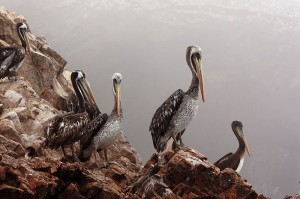 Sometimes called Peru’s little Galapagos, the rocky, barren looking Ballestas Islands are home to a rich variety of marine life.
Sometimes called Peru’s little Galapagos, the rocky, barren looking Ballestas Islands are home to a rich variety of marine life.
The most famous inhabitants are the sea lions. Colonies of these beasts bask on the sandy shores and put on a show by diving through the waves and coming quite near to the tour boats. The sea lions also bark. When the whole colony gets going, the cries resound off of the rocky islands and create a weird 360 degree surround sound effect. If you come in March, you will be able to see the mother sea lions with their pups.
The islands are also popular with birders, as thousands of birds circle in the air, divebomb the water to feed, and nest in the rocky cliffs. Humboldt penguins are often seen, as they nest on the islands. Other types of birds include pelicans, cormorants, boobies, and Incan terns. All those birds mean that there is also a lot of bird poop, or guano. When the islands were first discovered, some of the guano deposits were over 200 feet deep! Before the invention of chemical fertilizers, guano was an resource for farmers. This natural fertilizer was extremely valuable, and the guano deposits were quickly depleted. Even today, people still come to the islands to collect guano.
Tourists are not allowed to explore the islands on foot, but you can take a 2 hour boat tour that will bring you right up to the shores of the islands and allow for excellent opportunities to view sea lions, birds, and penguins. If you are lucky, you may also see some dolphins frolicking in the waves alongside the boat as you cruise over to the islands. Tours of the Ballestas are often offered in combination with a trip to the nearby Paracas Reserve.